Contributory members are able to log private notes and comments about each site
Sites Anne T has logged. View this log as a table or view the most recent logs from everyone
Woodburnhill (East Woodburn)
Trip No.33 Entry No.2 Date Added: 10th Jul 2017
Site Type: Ancient Cross
Country: England (Northumberland)
Visited: Yes on 8th Jul 2017. My rating: Condition 3 Ambience 4 Access 4
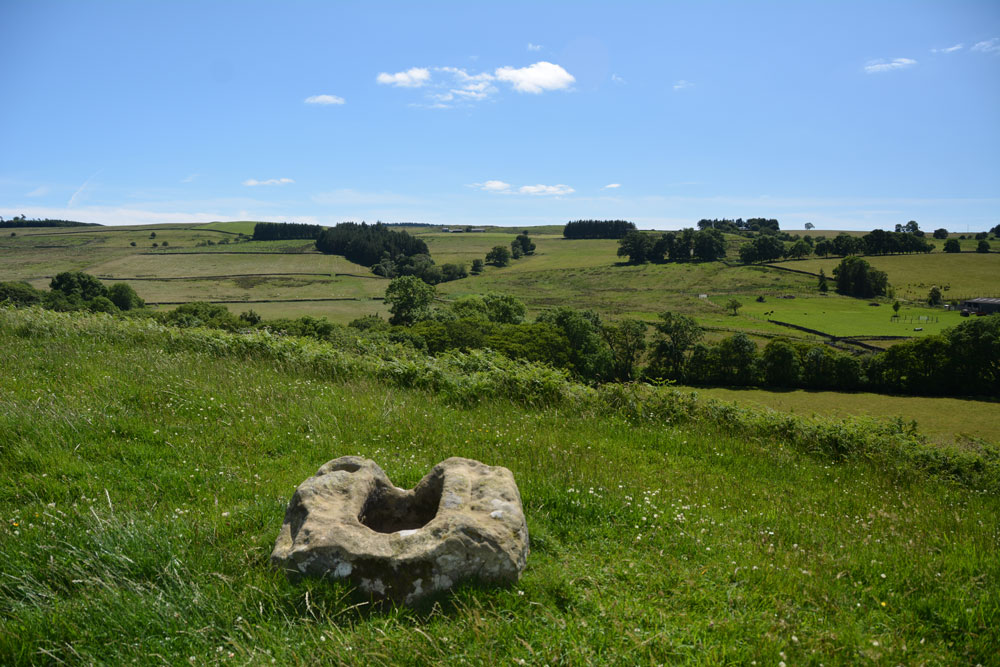
Woodburnhill (East Woodburn) submitted by Anne T on 10th Jul 2017. Looking south east across the Lisles Burn valley towards Stidlehill Common.
(View photo, vote or add a comment)
Log Text: Cross base near Woodburnhill Farm, Northumberland: Trying to find the footpath near Parkhead Farm to Robin of Risingham, I spotted the ‘cross (rems of)’ on the OS map just outside East Woodburn at Chairford Bridge.
As this wasn’t far away, we decided to explore. Parking at the northern side of the hamlet of Chairford Bridge, opposite the gate and track to Woodburnhill Farm, we let ourselves into the field and walked up towards the farm.
The cross base is sited on a small mound some 150 metres west of the farmhouse, not quite at the top of the hill. There are lovely views back to Chairford Bridge, south over the Lisles Burn valley and north to Darney Crag quarries and Hartside.
The cross base is roughly hewn but the socket is more substantial (larger) than others we’ve seen recently. The cross shaft would have been visible from a good way around.
Having found this spot, there are cairns and enclosures nearby which it would be nice to come back to.
Robin of Risingham (Woodburn)
Trip No.33 Entry No.1 Date Added: 10th Jul 2017
Site Type: Carving
Country: England (Northumberland)
Visited: Yes on 8th Jul 2017. My rating: Condition 3 Ambience 3 Access 4
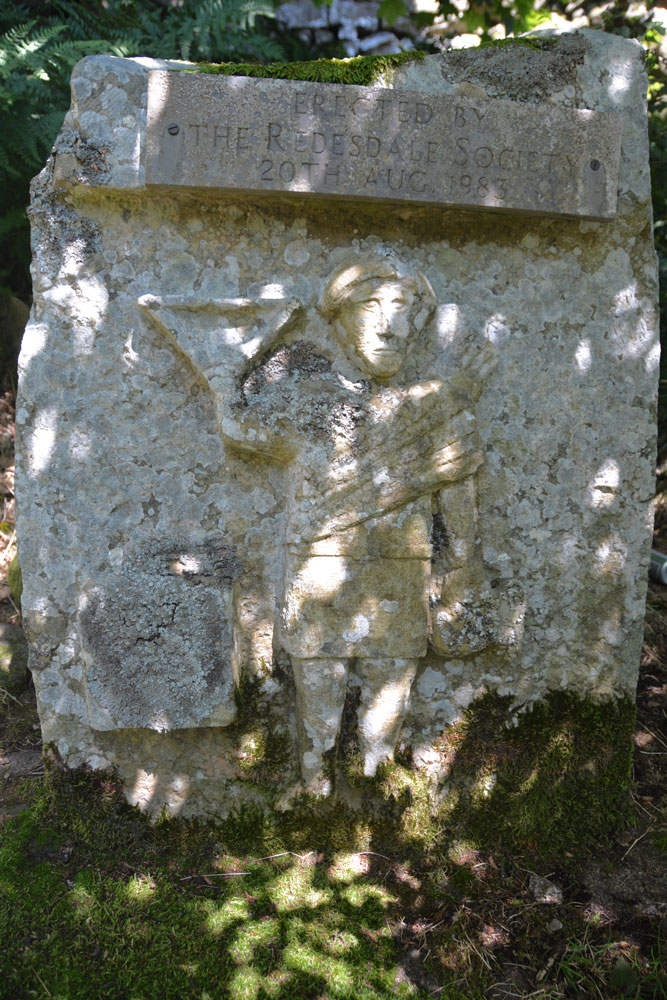
Robin of Risingham (Woodburn) submitted by Anne T on 9th Jul 2017. The carving (a half sized modern replacement put here by Redesdale Society in 1983). Behind this carved stone there is a gap of a few inches then a huge, odd shaped boulder. Despite numerous searches on the internet we've been unable to find where the remains (the legs) of the original carving are currently kept. They didn't appear to be on the boulder - we looked long and hard.
(View photo, vote or add a comment)
Log Text: Robin of Risingham, West Woodburn: Our first stop of the day, just south of West Woodburn on the A68. The sun was shining, it was warm and there was barely a breeze apart when the many motorbikes whizzed past at high speed.
Conveniently, there is a layby next to the start of the footpath leading from the A68 to Parkhead Farm at NY 90466 85463. Letting ourselves in through the gate into the field, the view was picturesque with views across the River Rede Valley to the west and pretty sheep and their large lambs.
We were keen to see this as the Historic England entry says this is the only known Roman statue carved from rock in Northumberland.
Making our way to the southern edge of the farm, there was a track leading through the field just to its east, just above their driveway. Following this to the end of the field, there was no way out – no stile, no sign, nothing. We retraced our steps and tried to find a different way past the farm buildings and ended up in a barn with some wonderful horses. In the end, we let ourselves into the farmyard and walked down the driveway, hoping to come across someone so we could ask where the proper path was.
There are some 3 to 4 houses along your left hand side here. Walking past the last one, Robin can be found about 100 metres further along the driveway. Husband Andrew then headed up the short tree covered slope to the wall separating the farm drive from the quarries above and found the carving hidden amongst the trees.
The dappled sunlight coming through the trees made this tricky to photograph. All the literature we’ve read said only the legs remain. We hunted for ages to see if they were on the rock behind the modern replica, or on the surrounding stone walls.
The intention later was to find the Roman Tombs on Otterburn Ranges which weren’t being used for military training this weekend, but we spent so long on other sites that we left this for another day.
Glaisdale Rigg (Hill Top)
Trip No.32 Entry No.10 Date Added: 6th Jul 2017
Site Type: Marker Stone
Country: England (Yorkshire (North))
Visited: Yes on 2nd Jul 2017. My rating: Condition 3 Ambience 4 Access 5
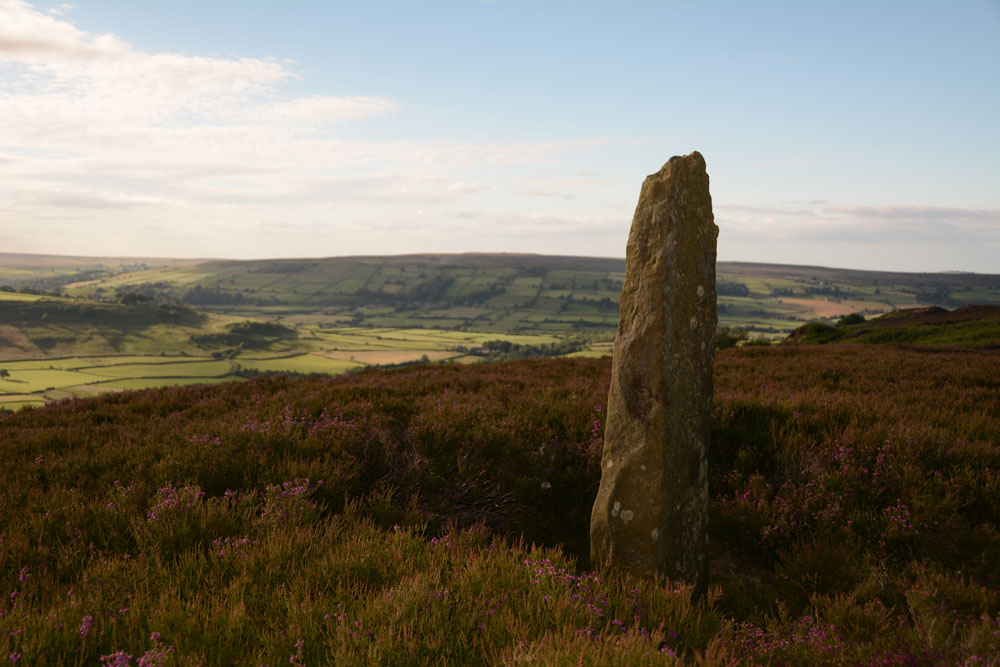
Glaisdale Rigg (Hill Top) submitted by Anne T on 6th Jul 2017. This stone stands proudly at the western side of the moorland road running northwards along Glaisdale Rigg. It is not far from the trig point and about 700 metres from Black Hill Cross. There are splendid views westwards across Great Fryup Dale.
(View photo, vote or add a comment)
Log Text: Glaisdale Rigg Standing Stone: From Hart Leap, we were making our way home. Spotting this, I got my husband to virtually do an emergency stop as I spotted this stone at the side of the road. There is nothing on Pastscape or Historic England about this stone, but it lies just under 700 metres north north east of Black Hill Cross/Standing Stone.
It stands proudly at the western side of Glaisdale Rigg, about a metre or so from the western side of the moorland road, virtually in line with Hill Top Farm in the valley below. It has great views over Great Fryup Dale, and looking south west to where Great and Little Fryup Dales meet.
It was a nice find to end the evening with.
Hart Leap Stones
Trip No.32 Entry No.9 Date Added: 6th Jul 2017
Site Type: Misc. Earthwork
Country: England (Yorkshire (North))
Visited: Yes on 2nd Jul 2017. My rating: Condition 2 Ambience 4 Access 5

Hart Leap Stones submitted by kelpie on 7th Jul 2002. Said to mark the dying leap of a hunted hart these are probably the remains of a stone row. NZ 73476 03555
(View photo, vote or add a comment)
Log Text: Hart Leap, Glaisdale Rigg: From the Black Hill Cross/Standing Stone, despite having the grid references for this site, we drove past it twice and had to park up and get out and explore. Fortunately there was a moorland track heading eastwards across the moor with room to pull up in. In driving further north along the road, there is another trig point, TP3365 (Glaisdale Rigg).
Exploring first to the east of the road, we spotted two stones lying low in the grass. The earthwork is barely discernible on the eastern side of the road, but is much clearer on the west. We walked the bank on the western side. The Historic England entry mentions a third stone on the eastern side of the road, but we didn’t spot this.
I’m certainly pleased to have been ‘out and about’ with the archaeology group, as at least I could start to interpret what I was seeing on the ground. The site has superb views over Great Fryup Dale.
Glaisdale Rigg Tall Cairn
Trip No.32 Entry No.8 Date Added: 5th Jul 2017
Site Type: Cairn
Country: England (Yorkshire (North))
Visited: Yes on 2nd Jul 2017. My rating: Condition 3 Ambience 4 Access 4
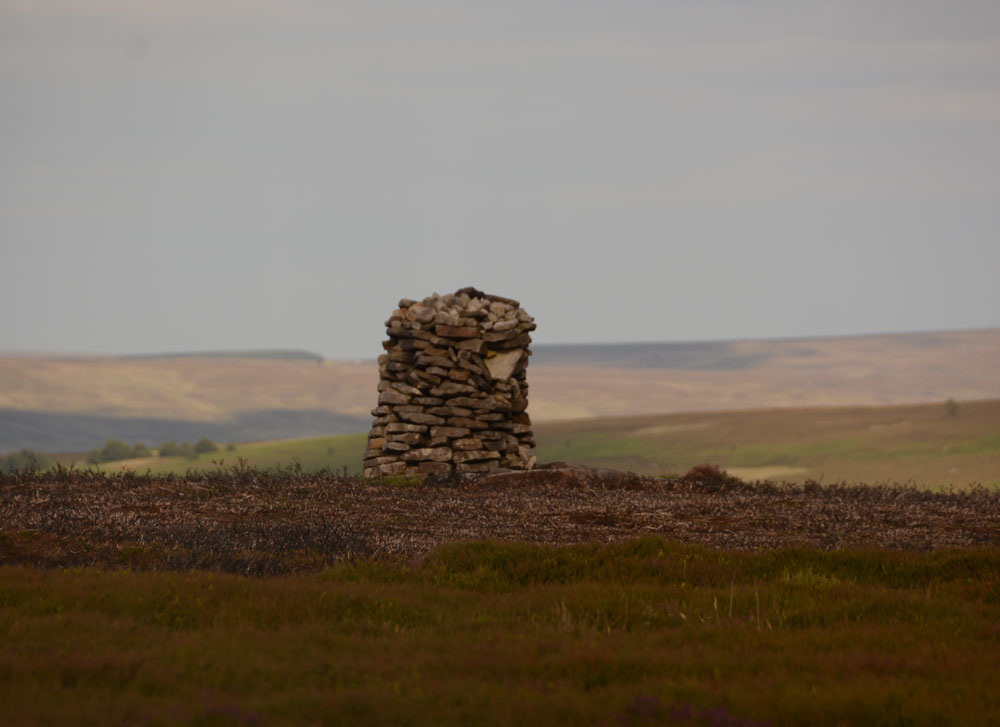
Glaisdale Rigg Tall Cairn submitted by Anne T on 4th Jul 2017. This modern tall dry stone cairn sits about 100 metres east of the Glaisdale Rigg moorland road, 500 metres south of a nearby Trig Point (TP3365 at NZ 74060 04148) and just north of Hart Leap, a Bronze Age boundary feature.
(View photo, vote or add a comment)
Log Text: Glaisdale Rigg Dry Stone Cairn, North Yorkshire: I spotted this whilst we were walking along the road to find Hart Leap. It looks relatively modern (there are lots of grouse shooting butts in the area) but by this late in the evening and after having walked seemingly miles across knee deep heather, my feet and ankles declined to go any further on this uneven ground, so I admired it from a distance.
When I got home, I found out it featured on the North Yorkshire Moors CAM web site from 2001, asking anyone who knew when and why this was built to contact them. I sent an email off to the author who replied virtually by return. He told me they never did find out any information, but he "did read that it was there in 1965."
Black Hill Cross (Glaisdale Rigg)
Trip No.32 Entry No.7 Date Added: 5th Jul 2017
Site Type: Ancient Cross
Country: England (Yorkshire (North))
Visited: Yes on 2nd Jul 2017. My rating: Condition 3 Ambience 4 Access 5
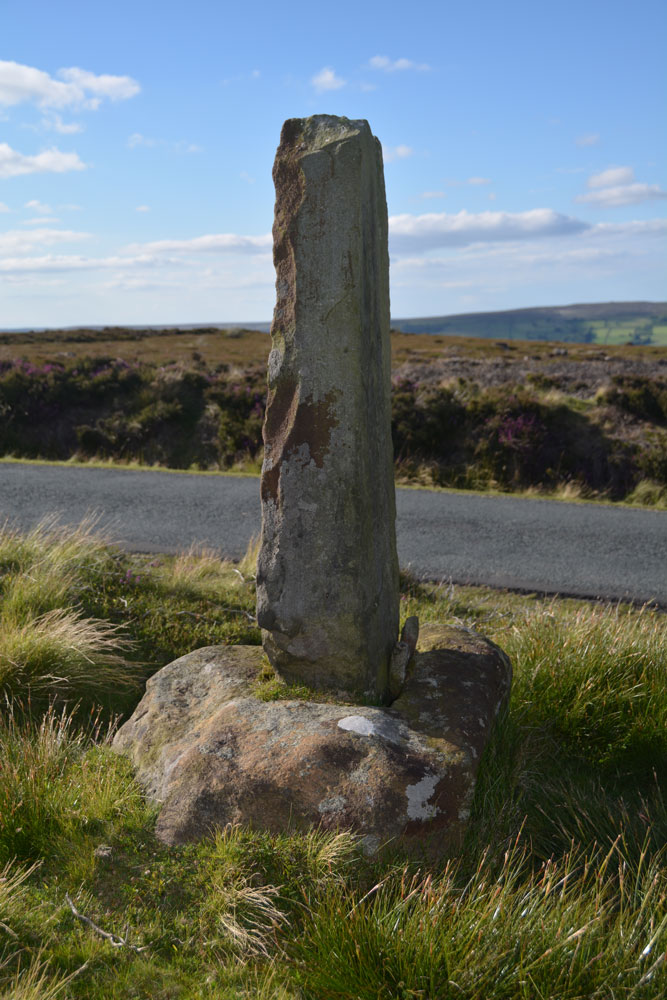
Black Hill Cross (Glaisdale Rigg) submitted by Anne T on 5th Jul 2017. This wayside cross must have been a welcome sight in the middle of this isolated (but beautiful) moorland, especially in the winter months. The base is crudely carved; the shaft looks like a modern addition.
(View photo, vote or add a comment)
Log Text: Black Hill Cross, Glaisdale Rigg: From Danby Rigg, we made our way to Glaisdale Rigg. I’ve been to some surprisingly beautiful parts of England before, but this was Pretty with a capital ‘P’. We needed the map to follow the surprisingly windy (and hilly) roads through Street village to Glaisdale Rigg.
Whilst described as a standing stone on the OS map this is clearly an old cross base with a more recent cross shaft wedged in. It must have been a very welcome sight to travellers, especially during winter months, in this very isolated piece of moorland. Well worth stopping to appreciate the views, especially as it was on our way to Hart Leap.
Danby Rigg Cairn With Standing Stone
Trip No.32 Entry No.6 Date Added: 5th Jul 2017
Site Type: Ring Cairn
Country: England (Yorkshire (North))
Visited: Yes on 2nd Jul 2017. My rating: Condition 2 Ambience 4 Access 3
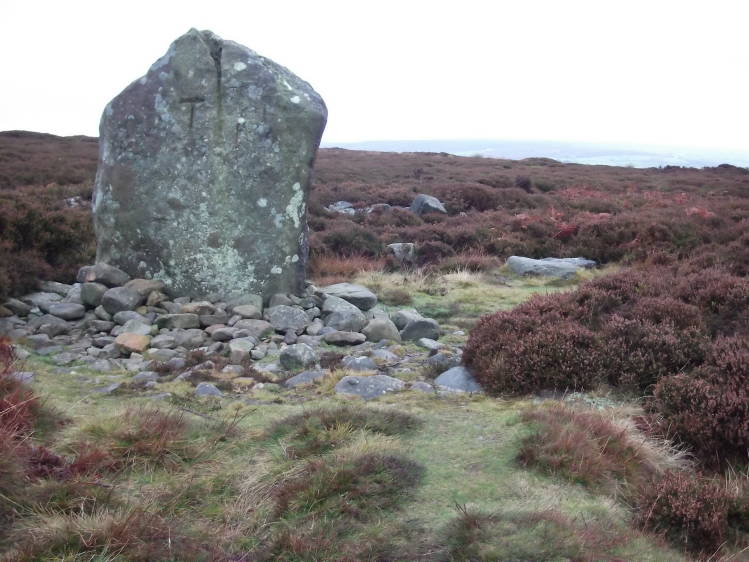
Danby Rigg submitted by tlgreen on 11th Sep 2011. Standing stone on Ainthope Rigg, remnant of a former stone circle.
(View photo, vote or add a comment)
Log Text: Danby Rigg Ring Cairn with Standing Stone, North Yorkshire: Of all the sites on Danby Rigg, this was the one I wanted to see most of all, especially after seeing the photos on the Portal, and I wasn't disappointed, although rather than a stone circle, I found a ring cairn with standing stone. The views to the west to Danby Dale and Little Fryup Dale were lovely on this cloudy, but warm, afternoon.
I was very aware of being in a very ancient landscape and there appeared to be many cairns popping out of the ground (where the heather had been burnt away) and vegetation covered low mounds everywhere.
The cairn is recorded on Pastscape (Monument ID 28809) and also Historic England, where the whole Danby Rigg landscape is recorded 'en masse'. The latter says: "The northernmost, which incorporates a standing stone, was excavated by Atkinson in 1863 and re-excavated in 1986-89. At the centre of the ring cairn there was a 1.7m by 1.1m pit containing two Bronze Age cremation urns and a large quantity of burnt bone. The stones of the ring bank were uncovered but not removed during the excavation and further archaeological remains are expected to survive underneath."
There was a further way marker along the track to the west towards Danby Dale.
Danby Rigg Marker Stone (Crossley Gate)
Trip No.32 Entry No.5 Date Added: 10th Jul 2017
Site Type: Marker Stone
Country: England (Yorkshire (North))
Visited: Yes on 2nd Jul 2017. My rating: Condition 3 Ambience 4 Access 3
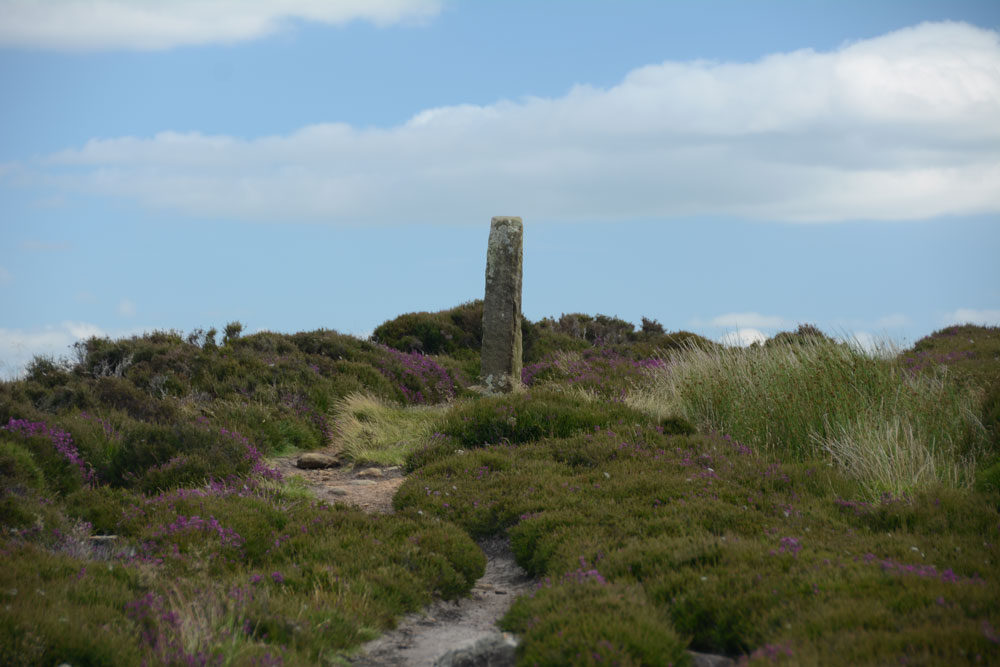
Danby Rigg Marker Stone (Crossley Gate) submitted by Anne T on 9th Jul 2017. Having walked about 100 metres down the track towards the ring cairn with standing stone, I turned back to look at this marker/standing stone, which is very visible to walkers on the horizon.
(View photo, vote or add a comment)
Log Text: Danby Rigg Marker Stone (Crossley Gate), North Yorkshire: this isn't marked on the OS map, but it is scheduled and listed on Pastscape. It is in a beautiful spot looking east to Lower Fryup Dale and marks the junction of two paths - one which comes up from the valley to the east, the track that runs along the eastern side of the rigg, and the northern most track that leads across the rigg from Lower Fryup Dale to Danby Dale, leading past the ring cairn with standing stone.
The stone working markings on the stone make it look like a modern replica, although Pastscape says it's medieval. Being so close to the nearby cross-dyke and round cairn, it is very much like walking in the footsteps of the people who lived on the ridge all those many years ago.
Danby Rigg (Crossley Gate)
Trip No.32 Entry No.4 Date Added: 5th Jul 2017
Site Type: Cairn
Country: England (Yorkshire (North))
Visited: Yes on 2nd Jul 2017. My rating: Condition 2 Ambience 4 Access 4
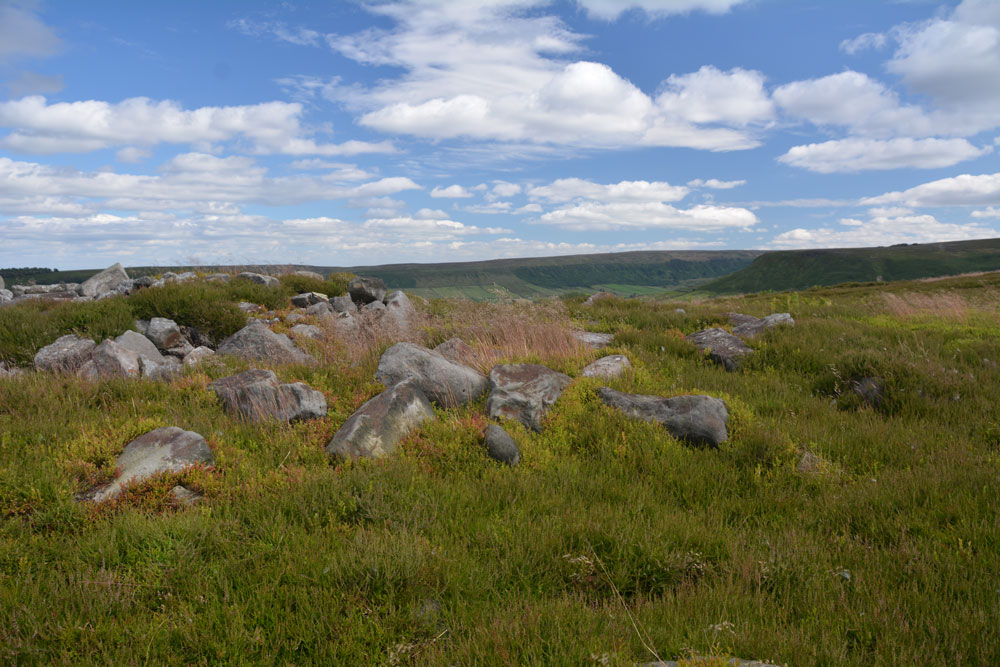
Danby Rigg (Crossley Gate) submitted by Anne T on 4th Jul 2017. Standing on the western side of the cairn looking towards Little Fryup Dale.
(View photo, vote or add a comment)
Log Text: Round cairn overlooking Crossley Gate, Danby Rigg, North Yorkshire: From the other marker stones along the track between Little Fryup Dale and Danby Dale, we walked back to the trig point, then took the footpath (mountain bike track) headed north east along the path that runs along the eastern edge of Danby Rigg. There are great views down to Lower Fryup Dale below. Even I managed this path. There was a steady breeze, which got stronger as the afternoon progressed, but it was warm and relatively easy walking until we headed off into the heather.
We first saw the long, low cross dyke just before the cairn. This mound was largely hidden in the tall heather, which had just started to flower, attracting the steady buzz of the worker bees. I could make out the stones in the mound.
This cairn is just to the north of this cross dyke and is prominent with its stoney mound surrounded by bright green growth which shows up the circular nature of the feature. On the horizon to the west it looks as if other low cairns pop up out of the heather.
Danby Rigg Cross Dyke (Crossley Side)
Trip No.32 Entry No.3 Date Added: 5th Jul 2017
Site Type: Misc. Earthwork
Country: England (Yorkshire (North))
Visited: Yes on 2nd Jul 2017. My rating: Condition 2 Ambience 4 Access 4
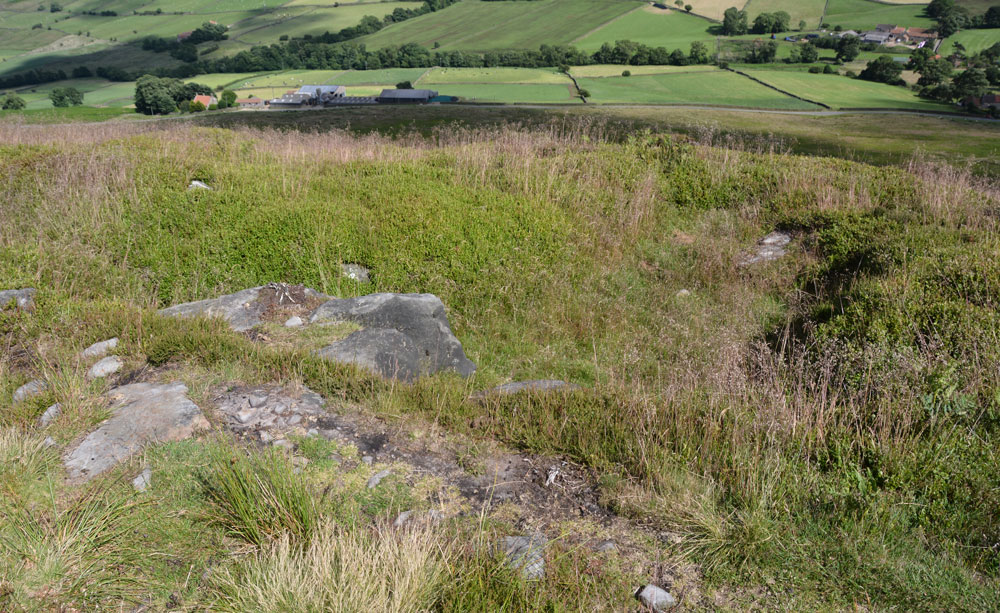
Danby Rigg Cross Dyke (Crossley Side) submitted by Anne T on 5th Jul 2017. Standing some 10 metres from the footpath in the middle of the cross dyke looking down into Little Fryup Dale with Crossley House Farm below.
(View photo, vote or add a comment)
Log Text: Danby Rigg Cross Dyke (Crossley Side), North Yorkshire: From the standing stone (marker stone) and trig point, we walked along the footpath leading approx. north east along the eastern side of the ridge towards the large round cairn. I confess to having walked past this at first, almost reaching the round cairn, but turned round and spotted the long, low hump rising out of the heather.
Walking along the earthwork, it is made of earth and stones and feels substantial under the feet. What a view down to Lower Fryup Dale and Crossley House Farm below.
I was keen to photograph this and the cairn and move onto the 'stone circle'. So much to see on this ridge - it's a very complex Bronze Age landscape. I had no idea how much was here until we started walking. A very beautiful part of the world.
Danby Rigg Marker Stones
Trip No.32 Entry No.2 Date Added: 10th Jul 2017
Site Type: Marker Stone
Country: England (Yorkshire (North))
Visited: Yes on 2nd Jul 2017. My rating: Condition 3 Ambience 4 Access 4
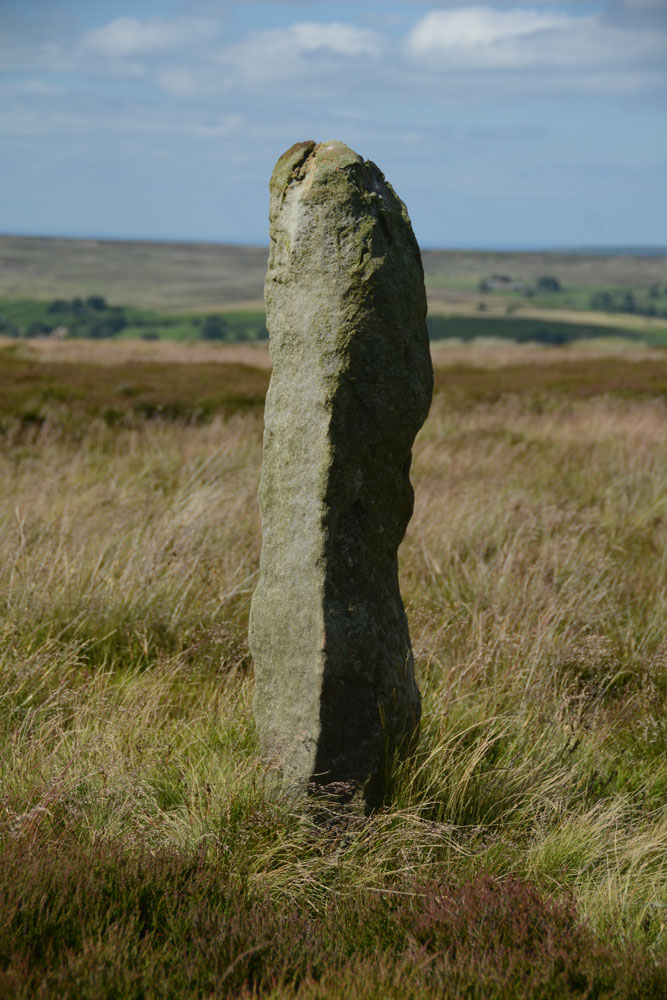
Danby Rigg Marker Stones submitted by Anne T on 9th Jul 2017. This is the same stone from a different angle, looking north east across the moorland towards Ainthorpe village. It s a lonely spot, which could be very wild in winter months.
(View photo, vote or add a comment)
Log Text: Danby Rigg Marker Stones, North Yorkshire: I was really surprised to find these marker stones on top of the moor, running from the Standing Stone and trig point in line with Slate Hill to Danby Dale.
We didn't walk to all of them, as we wanted to get across to the cross dyke, round cairn and ring cairn on the northern side of the ridge.
As an olden-day traveller, particularly in winter months, I would have been grateful to have seen these stones marking the way. Beautiful views.
Danby Rigg (Slate Hill)
Trip No.32 Entry No.1 Date Added: 5th Jul 2017
Site Type: Marker Stone
Country: England (Yorkshire (North))
Visited: Yes on 2nd Jul 2017. My rating: Condition 4 Ambience 4 Access 4

Danby Rigg (Slate Hill) submitted by Anne T on 4th Jul 2017. First view of this marker stone and the trig point (TP2728 at NZ 70788 05869) on the eastern edge of Danby Rigg.
(View photo, vote or add a comment)
Log Text: Marker/Standing Stone & Trig Point, Danby Rigg, North Yorkshire: Not marked on the OS map, this stone sits within a couple of metres of Trig Point TP2728 (Danby Moor). It is sited almost on the eastern edge of Danby Rigg, where the ridge starts to slope sharply down to Little Fryup Dale. There is no information recorded about it on Pastscape, although their information for the area indicates a number of way markers, some scheduled, which mark the route of a medieval footpath which runs from Slate Head to Ainthorpe. Other way markers (such as this) mark out two separate footpaths from Little Fryup Dale in the east to Danby Dale at the western most side of the ridge. This sits at the side of the western most track, continuing the farm track east-west over the ridge.
The area has a long history and plays host to many features, including cairn cemeteries, cross dykes, cairn circles and round cairns, many dating to the Bronze Age and possibly Neolithic.
The easiest way to reach this stone and trig point is to walk from (or park at) the cross roads just to the south of Slate Hill House (where Castle Lane, New Way and Slate Hill meet). There is a farm track and a footpath starting almost from the same point up to the top of Danby Rigg. The footpath is somewhat overgrown and steep towards the top, so we followed the well used farm track which heads almost directly west then tracks north east up the slope. Almost as soon as the path levels out, you see the stone and the trig point. The views back towards where Little Fryup Dale meets Great Fryup Dale. The views across these valleys and northwards back towards Ainthorpe are stunning.
Carby Hill
Trip No.31 Entry No.5 Date Added: 30th Jun 2017
Site Type: Ancient Village or Settlement
Country: Scotland (Scottish Borders)
Visited: Saw from a distance on 24th Jun 2017. My rating: Condition 2 Ambience 4 Access 3
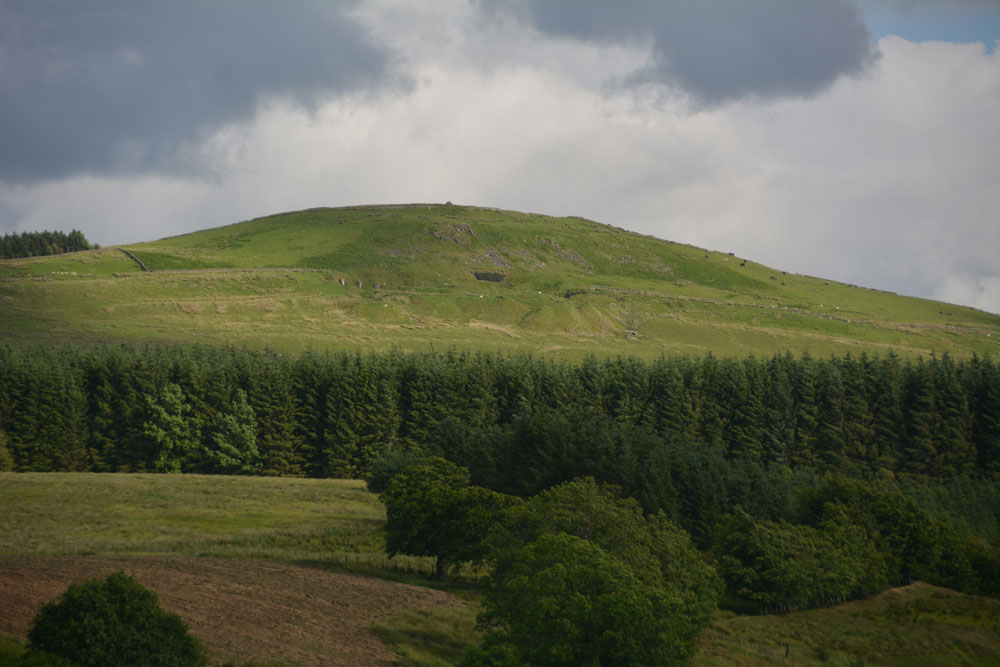
Carby Hill submitted by Anne T on 25th Jun 2017. We only saw Carby Hill Settlement from the Milnholm Cross just south of Newcastleton, then again from the track by the quarry just below the fort/settlement. When we arrived, we saw some enormous cattle grazing the site. Even my husband balked, and he was brought up on a farm and is used to these beasts. Looking forward to a return trip in the not too distant future - it looks amazing.
(View photo, vote or add a comment)
Log Text: Carby Hill Settlement, Scottish Borders: We only got to see this from a distance because of the ENORMOUS cattle grazing it's slopes. Even my husband, who was brought up on a farm was wary of these beasts. We plan to come back for a repeat visit in a month or so. Whilst the hill looks steep, from the path from the nearby quarry towards the base of the hill, the climb didn't look too bad.
Milnholm (Newcastleton)
Trip No.31 Entry No.4 Date Added: 30th Jun 2017
Site Type: Ancient Cross
Country: Scotland (Scottish Borders)
Visited: Yes on 24th Jun 2017. My rating: Condition 3 Ambience 4 Access 5
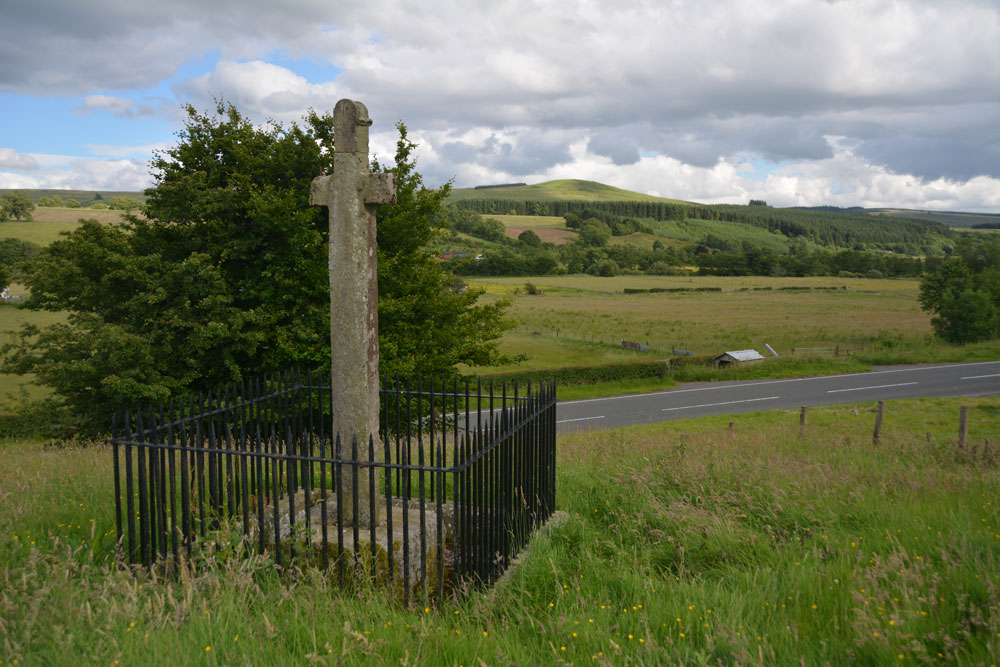
Milnholm (Newcastleton) submitted by Anne T on 30th Jun 2017. Standing behind the cross looking over to Carby Hill Settlement (middle right of the photograph).
(View photo, vote or add a comment)
Log Text: Milnholm Cross, Newcastleton: Not my usual type of cross, but interesting nevertheless. This cross sits just to the south of Newcastleton Village, on the right hand side of the B6357. There is a small layby at NY 47633 86073 where a side road heads off up the hill, signposted to Ettleton cemetery. It is very reminiscent of a site near Eskdalemuir that we visited some time ago. Carby Hill settlement can be clearly seen to the south-west.
The railings made it quite difficult to photograph the cross properly. I wasn’t that enamoured of it, or the location (more interested in going up to the cemetery at Ettleton, but we didn’t go there). There is an interpretation board at the base of the steps.
Gibbie's Knowe (Kielder)
Trip No.31 Entry No.3 Date Added: 19th Jun 2017
Site Type: Ancient Village or Settlement
Country: England (Northumberland)
Visited: Yes on 17th Jun 2017. My rating: Condition 3 Ambience 5 Access 3

Gibbie's Knowe (Kielder) submitted by Anne T on 19th Jun 2017. About 200 metres further south along the track, the whole of Gibbie's Knowe defended Iron Age settlement comes into view. It sits within a loop of Kielder Burn.
(View photo, vote or add a comment)
Log Text: Gibbie's Knowe, Kielder Forest: After our long trek up to Dour Hill Chambered Cairn, the heat was definitely getting to both of us. Andrew decided to drive the 12 miles down the Forest Drive toll road from Cottonshopeburnhaugh to Kielder. Goodness, this road is remote, but lovely.
We stopped off to see Gibbie’s Knowe, an Iron Age defended settlement, parking off Forest Drive just west of East Kielder Farm (there is a small layby at NY 65257 95857) and following the track south-south-west up the slope towards Kielder Village. We were unable to get down to the mound, but retraced our steps and drove further west along Forest Drive to park in the layby and walk down the overgrown track to the site of an old observation hide (no longer there) at NY 64791 95234. A lovely spot, with the sun glinting off this deep loop of Kielder Burn.
Unfortunately, it was almost 6pm by this time, and we were flagging with the heat, so we abandoned our next walk to Devil’s Lapful long cairn.
Castleton (Newcastleton)
Trip No.31 Entry No.3 Date Added: 30th Jun 2017
Site Type: Ancient Cross
Country: Scotland (Scottish Borders)
Visited: Yes on 24th Jun 2017. My rating: Condition 1 Ambience 4 Access 5
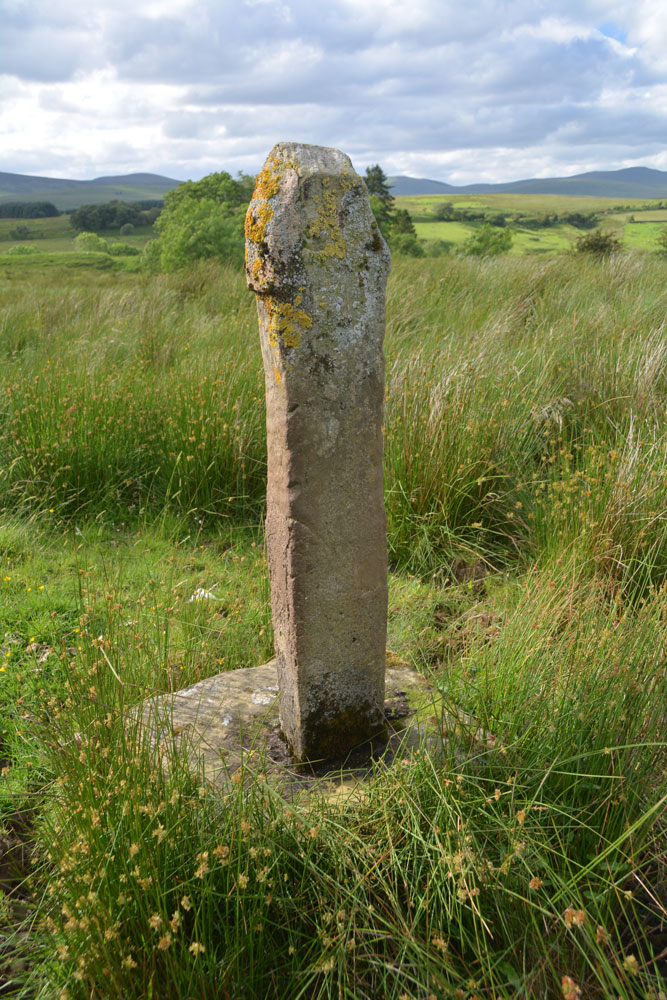
Castleton (Newcastleton) submitted by Anne T on 30th Jun 2017. Standing just behind the cross at its eastern side, looking back over the Liddel Water valleys.
(View photo, vote or add a comment)
Log Text: Castleton Cross, Near Newcastleton: Whilst this cross can be seen from the road, it is best viewed from the field (gate opposite the cemetery, otherwise its a clamber over a barbed wire fence in boggy ground). The shaft is a modern replacement, made of concrete. The field contains many lumps and bumps - the remains of the old village. This spot is virtually opposite Old Castleton earthworks (Liddel Castle) and with the enigmatic cemetery with its strange grave markers and brilliant views, it was well worth the stop. Shame the road was so busy at this time on night; cars whizzed by at 60 mph at regular intervals. Not the safest place to walk.
Rochester (Otterburn)
Trip No.31 Entry No.2 Date Added: 19th Jun 2017
Site Type: Modern Stone Circle etc
Country: England (Northumberland)
Visited: Yes

Rochester (Otterburn) submitted by Anne T on 19th Jun 2017. View of this modern stone circle from the gateway into the field from the rear of the Camien Café.
(View photo, vote or add a comment)
Log Text: Rochester (Otterburn) Modern Four Poster: We’ve seen this stone circle and a tumble-down round house whilst driving by on the A68 on a number of occasions but never stopped. However, today, after a hot but pleasant afternoon walking to Dour Hill Cairn, we doubled back to the café for refreshments and got chatting to the owners.
The café owners told us there used to be a round house here, but it was demolished by the University of Newcastle who ran the Brigantium project. There is now a timber faced building on the site and they intend using it for ‘Dark Skies’ and the Redefest music festival which is run on 1st weekend of August in Redesdale (this year it will be Friday 4th August to Saturday, 5th August). See https://redefest.org.uk/about-us.
Old Castleton (Newcastleton)
Trip No.31 Entry No.2 Date Added: 30th Jun 2017
Site Type: Misc. Earthwork
Country: Scotland (Scottish Borders)
Visited: Yes on 24th Jun 2017. My rating: Condition 2 Ambience 4 Access 4

Old Castleton (Newcastleton) submitted by Anne T on 30th Jun 2017. Approaching the earthworks from the north eastern end of the cemetery, there is a large 'motte' to the left hand side, a broad ditch (moat?) to the middle and a large bank/rampart to your right. To the middle left of the photograph the ground drops steeply (100 feet straight down!) into Liddel Water.
(View photo, vote or add a comment)
Log Text: Old Castleton Earthworks (Liddel Castle), Near Newcastleton: At the north-eastern end of the cemetery, there is a small iron gate which leads out onto the field with the earthworks. The gate had been tied fast, but rather than walk all the way round, I used my un-knotting skills (honed from many years of knitting with cats around) and let ourselves into the field. Whilst the earthworks seemed big viewed from the B6357, they were very large as we approached them.
I was surprised, on reaching the western flank of the earthworks that the ground disappeared straight down some 100 feet to the Liddel Water below on it’s western side and a small burn running north-south to its east. There appeared to be the remains of a large ditch (moat?) to its southern flank and the mound is further divided into two parts east-west across the middle
Very impressive. A lot of history in a small area round here, with St. Martin's cemetery and the old cross nearby.
Dour Hill (Rochester)
Trip No.31 Entry No.1 Date Added: 19th Jun 2017
Site Type: Chambered Cairn
Country: England (Northumberland)
Visited: Yes on 17th Jun 2017. My rating: Condition 2 Ambience 4 Access 3
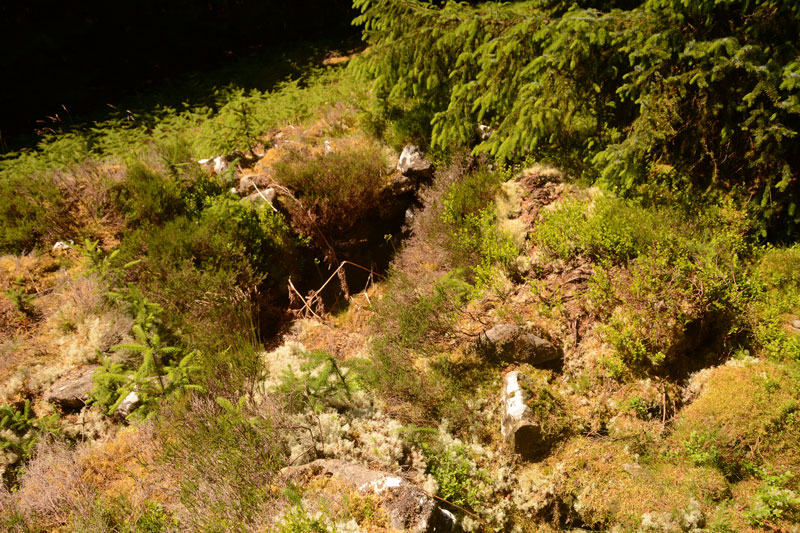
Dour Hill (Rochester) submitted by Anne T on 19th Jun 2017. This is the larger Bronze Age cist, sited towards the north western end of the cairn. We had to pull back a large conifer branch to get a clear view. This chamber was easily deeper and much more visible than the smaller chambers up and down the length of the cairn.
(View photo, vote or add a comment)
Log Text: Dour Hill Chambered Cairn, Near Otterburn: We picked the hottest day of the year so far to visit here, and climbed the gently sloping hill up past the very tall forest plantations towards the top of Dour Hill.
This visit was interesting as the army were carrying out exercises on the Otterburn Ranges less than 400 metres away. They must have been at the top of Dour Hill as, as soon as we'd reached the cairn, there was an almighty boom and the ground under our feet trembled with the ordnance being fired. On the way back to the A68 we heard the radios and voices not far away.
Unlike Bellshiel Law chambered cairn, this cairn sits in a forest clearing and nature has been allowed to reclaim it. The chambers can still be made out, and there is a large, deep Bronze Age cist cut into the cairn to the north west of its middle section (I had to pull back a large conifer branch to photograph it properly).
Well worth the walk. Would have liked to have seen the Bronze Age round cairn some 170 metres to its east but the forest was dense and we missed it.
Caddrounburn Calvert
Trip No.31 Entry No.1 Date Added: 26th Jun 2017
Site Type: Ancient Village or Settlement
Country: Scotland (Scottish Borders)
Visited: Yes on 24th Jun 2017. My rating: Condition 2 Ambience 4 Access 5

Caddrounburn Calvert submitted by Anne T on 26th Jun 2017. Standing near the north west corner of Enclosure B, looking south west towards Liddel Water. The ditch between Enclosure B and Enclosure B can be seen to the middle right of the photo.
(View photo, vote or add a comment)
Log Text: Caddrounburn Calvert, Scottish Borders: [Note: whilst the site can be seen from the road by Liddel Water, it is a short climb up the slope to walk round the exterior walls of the settlement. I found the tussocks of grass and hidden lumps of stone challenging on my ankles, but took a walking pole to help.]
Following the road to the west of Kielder Water, this twists and turns gently through the countryside. The border here takes some interesting lines, but we ascertained we were just into the Scottish Borders. This fort/settlement is in a lovely spot overlooking a bend of Liddel Water. The grass was almost knee high, but it was still possible to make out Enclosure B from the road. To the western side of Enclosure B, there was a deep ditch and the start of another boundary feature, but the grassy was too long and lush to make out much of Enclosure B at this time of year.
We parked on the south side of the road at NY 58270 98319, where it widens out very slightly on a bend (avoiding the sheep and their large lambs who were totally unperturbed by the car) and headed up the slope to Enclosure B.
The banks are high (up to 1.5 metres) in places, clearly made up of stones and earth. Whilst not quite a square, the corners are well rounded and there is an about 8 foot wide entrance at its south western corner. The banks appear to be between 3 to 4 meters wide, including the tumble at either side. There was a north-south bank from about the middle of Enclosure B to about half way down the enclosure, before it petered out. I (stupidly) thought this was the division between Enclosure A & B, but looking at the site on UK Grid Reference Finder once I got home, I was sadly mistaken! We’d missed Enclosure A completely, although I did spot the ditch dividing the two areas. The grass was very lush and thick, and any banks of Enclosure A were certainly hidden from both the road and Enclosure B. I’d love to see this site again in the winter.
